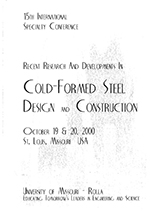Session Dates
19 Oct 2000
Abstract
Crest-fixed steel claddings made of thin, high strength steel often suffer from local pull-through failures at their screw connections during high wind events such as storms and hurricanes. Currently there aren't any adequate design provisions for these cladding systems except for the expensive testing provisions. Since the local pull-through failures in the less ductile steel claddings are initiated by transverse splitting at the fastener hole, analytical studies have not been able to determine the pull-through failure loads. Analytical studies could be used if a reliable splitting criterion is available. Therefore a series of two-span cladding tests was conducted on a range of crest-fixed steel cladding systems under simulated wind uplift loads. The strains in the sheeting around the critical fastener holes were measured until the pull-through failure. This paper presents the details of the experimental investigation and the results including a strain criterion for the local pull-through failure.
Department(s)
Civil, Architectural and Environmental Engineering
Research Center/Lab(s)
Wei-Wen Yu Center for Cold-Formed Steel Structures
Meeting Name
15th International Specialty Conference on Cold-Formed Steel Structures
Publisher
University of Missouri--Rolla
Document Version
Final Version
Rights
© 2000 University of Missouri--Rolla, All rights reserved.
Document Type
Article - Conference proceedings
File Type
text
Language
English
Recommended Citation
Mahaarachchi, Dhammika and Mahendran, Mahen, "Pull-through Failures of Crest-fixed Steel Claddings Initiated by Transverse Splitting" (2000). CCFSS Proceedings of International Specialty Conference on Cold-Formed Steel Structures (1971 - 2018). 6.
https://scholarsmine.mst.edu/isccss/15iccfss/15iccfss-session10/6
Pull-through Failures of Crest-fixed Steel Claddings Initiated by Transverse Splitting
Crest-fixed steel claddings made of thin, high strength steel often suffer from local pull-through failures at their screw connections during high wind events such as storms and hurricanes. Currently there aren't any adequate design provisions for these cladding systems except for the expensive testing provisions. Since the local pull-through failures in the less ductile steel claddings are initiated by transverse splitting at the fastener hole, analytical studies have not been able to determine the pull-through failure loads. Analytical studies could be used if a reliable splitting criterion is available. Therefore a series of two-span cladding tests was conducted on a range of crest-fixed steel cladding systems under simulated wind uplift loads. The strains in the sheeting around the critical fastener holes were measured until the pull-through failure. This paper presents the details of the experimental investigation and the results including a strain criterion for the local pull-through failure.



